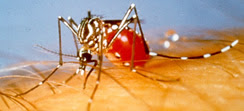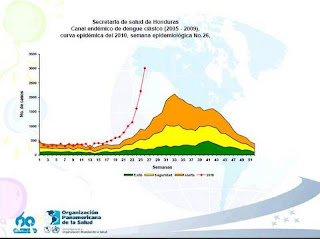Aedes aegypti mosquito,
very distinctive and easily recognized
very distinctive and easily recognized
The Honduran dengue epidemic I wrote about in June continues. At one point, there was even mention of it turning into a hyper-epidemic, though more recent reports seem to indicate that there is a reduction in numbers being admitted to hospitals, "a 25% reduction last week and 13% the week before", according to the Minister of Health, Arturo "Tuki" Bendaña last week. More on that statement below.
Bad numbers
The statistics are something hard to pin down as most people do not go to a doctor for dengue (there is no real treatment), and it's doubtful that private doctors report all of the cases that they treat. In fact, an August 14 La Prensa article flatly states that the private hospitals are not reporting dengue statistics at all because they say they "care for their prestige". [What the...??] Miraculously, even though those statistics are not reported, La Prensa says they are somehow "included in the total numbers reported by the Minister of Health". Disputed in that same article, a regional director admitted that they don't have accurate statistics.
 (The same Aedes Aegypti mosquito, but this time engorged on human blood)
(The same Aedes Aegypti mosquito, but this time engorged on human blood)Providing further doubt of the validity of the statistics is the 'Honduran math' in which a decrease to 5,162 new cases in Week 32 from 5,253 new cases in Week 31 was announced on television as a big success, "a 25% decrease in cases this week" according to the Minister. It just doesn't compute.
 In a later article on August 26, that was clarified to claim a 15% reduction from two weeks prior, not the week before and not 25%. Alas, it still doesn't compute! The math shows that the week 32 decrease was 1.7% and comparing it to two weeks prior results in a 13.7% decrease. Sadly, Honduran newspaper math is just as bad. They dutifully report what was said and they don't check the math or point out these errors of fact. Picking and choosing the comparative week just makes the Minister look bad, especially when he doesn't use the same week for the DH statistics.
In a later article on August 26, that was clarified to claim a 15% reduction from two weeks prior, not the week before and not 25%. Alas, it still doesn't compute! The math shows that the week 32 decrease was 1.7% and comparing it to two weeks prior results in a 13.7% decrease. Sadly, Honduran newspaper math is just as bad. They dutifully report what was said and they don't check the math or point out these errors of fact. Picking and choosing the comparative week just makes the Minister look bad, especially when he doesn't use the same week for the DH statistics.The other day on the news a doctor said that the test kits that the hospitals were using were worthless, that they were resulting in a lot of false positives and a lot of false negatives. So once again, it seems the government has wasted money on poor quality. Also, if the tests aren't accurate, how can the statistics be relied upon?
The statistics are also hard to believe because we have seen playing with the numbers in the past. In 2007, the number of cases was compared to an arbitrarily selected high incidence year (2002) rather than the prior year in order to show the situation was under control, but reporters didn't catch on to that for several months. Other times, there were lengthy delays (weeks) in the reporting of confirmed cases of dengue hemorrágico. This year, at times the year-to-date numbers are reported and other times it is the June-to-date numbers. Confusing to say the least.
 The red line in the chart is supposed to be actual cases in 2010. As best as I can tell, the green area signifies what would be considered "under control" while the orange area would be considered an ''alert" or epidemic. Like most data from the Minister of Health, it doesn't even make sense, since it only goes to 3,500 and as of week 26 (the supposed date of this chart), the count was already at 17,620 as shown earlier in this same report.
The red line in the chart is supposed to be actual cases in 2010. As best as I can tell, the green area signifies what would be considered "under control" while the orange area would be considered an ''alert" or epidemic. Like most data from the Minister of Health, it doesn't even make sense, since it only goes to 3,500 and as of week 26 (the supposed date of this chart), the count was already at 17,620 as shown earlier in this same report.In July, anonymous doctors at the Tegucigalpa hospital with the highest incidence of cases in the country accused the Health Department of hiding figures, telling reporters that there had been 50 deaths from dengue, not 19 as had been officially reported at the time (July 8). They also said that the Minister had forbidden public health employees from giving accurate statistics on pain of firing. Two public health doctors who criticized the dengue eradication campaign were fired.
So...there isn't much reason to rely on the statistics, but it is all we have and there isn't much chance that they have been overstated.
Latest statistics
I started writing this article about two weeks ago and decided to wait for the latest statistics. Week 32 statistics weren't given until the end of week 33. Then, I really wanted to check the veracity of that "25% decrease" statement. Last week's statistics were finally reported yesterday.
Official statistics as of week 33 (August 26) show that country-wide 53,700 [suspiciously round number?] people have been diagnosed with dengue clásico, 1,796 with dengue hemorrágico (DH), and 60 have died from dengue. These numbers finally show a significant decrease in new classic dengue cases, 29% from the previous week, but show a 5% increase in new confirmed DH cases, or a 28% increase over two weeks ago (since the Minister likes to use two weeks prior when convenient). This might have more meaning if they also reported the statistics for the backlog of cases stuck in the confirmation process each week.
By comparison, the counts for the entire year of 2009 in Honduras were as follows: 14,528 dengue, 604 DH, and 12 deaths. To see how totally out of control this year's epidemic is, check out these 2007 and 2006 statistics from my article about this same time of year in 2007.
An important thing to know which is not usually made clear by the newspaper articles is that more than 50% of Honduran cases of both dengue clásico and dengue hemorrágico (the potentially deadly type) have occurred in the capital, Tegucigalpa. Another 10% have occurred in the San Pedro Sula metropolitan area.
Even more interesting, in searching for the data, I ran across articles from January 2010 predicting the epidemic this year and indicating that the reported dengue cases in Tegucigalpa were already up 600% over the year before. So if the government knew it was coming, why didn't they do anything? Had appropriate actions been taken in that city earlier in the year, we might not have reached epidemic proportions.
Why Honduras?
As of week 31 (August 12), in all of Central America, 75% of the total deaths from dengue had occurred in Honduras, and 50% of the total deaths had occurred in Tegucigalpa. Comparing Honduras to its neighbors, Costa Rica has had only a little over 17,000 classic cases, the same as El Salvador. Guatemala, with almost double the population of Honduras, has had only about 7,500 cases of dengue clásico, 104 cases of DH and 15 deaths. Honduras represents about 18% of the Central American population.
Civic group Transformemos Honduras has quite a lot to say about the government's mishandling of the dengue epidemic this year. [This Google translation to English is worth reading.] This organization's well-documented article points out that not even basic steps were taken and places the blame squarely on the shoulders of the Health Minister, who among other things, placed a newly graduated doctor with no experience or specialization in the area of dengue or infectious diseases in charge of the program.
What is dengue?
Basically, classic dengue is like a very, very bad flu, with excruciating pains in the bones and joints and behind the eyes. If you aren't familiar with dengue, you could take a look at my 2007 article which gives lots of details and has some links to World Health Organization and US Center for Disease Control information. Only a certain type of mosquito carries the dengue virus and the only way the mosquito can contract it is by biting a human who has dengue. Dengue does not spread from person to person. While it is not easy, there are ways to control the proliferation of this mosquito, but instead, what we are seeing in Honduras is a spreading of dengue to areas which previously had very little incidence.
Why is Honduras being hit so much harder than other Central American countries?
See Part 2 tomorrow.





 Welcome to my Blogicito —
Welcome to my Blogicito — 







